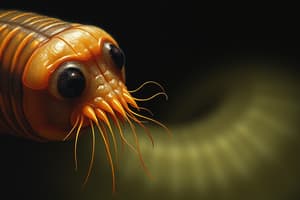Podcast
Questions and Answers
What is the main difference between the body shape of flatworms and nematodes?
What is the main difference between the body shape of flatworms and nematodes?
- Flatworms have a flat, bilaterally symmetrical body, while nematodes have a cylindrical body. (correct)
- Both flatworms and nematodes have a flat, bilaterally symmetrical body.
- Both flatworms and nematodes have a cylindrical body.
- Nematodes have a flat, bilaterally symmetrical body, while flatworms have a cylindrical body.
What anatomical feature do flatworms possess that nematodes lack?
What anatomical feature do flatworms possess that nematodes lack?
- Neither flatworms nor nematodes possess a coelom (body cavity).
- Flatworms possess a coelom (body cavity). (correct)
- Both flatworms and nematodes possess a coelom (body cavity).
- Nematodes possess a coelom (body cavity).
Which process is unique to the reproduction of flatworms?
Which process is unique to the reproduction of flatworms?
- Gestation
- Amphimixis
- Regeneration (correct)
- Asexual reproduction
What is the term for the process where the body of flatworms is divided into segments?
What is the term for the process where the body of flatworms is divided into segments?
What is the reason why understanding nematodes and flatworms is considered essential for comprehending the complexities of the natural world?
What is the reason why understanding nematodes and flatworms is considered essential for comprehending the complexities of the natural world?
What is the unique anatomical feature of roundworms?
What is the unique anatomical feature of roundworms?
How do nematodes obtain nutrients?
How do nematodes obtain nutrients?
In which part of the human body can nematodes be found?
In which part of the human body can nematodes be found?
How do nematodes reproduce?
How do nematodes reproduce?
What is the range of habitats where nematodes can be found?
What is the range of habitats where nematodes can be found?
Study Notes
Phylum Nematoda: Exploring the Fascinating World of Roundworms
Phylum Nematoda, often referred to as roundworms, consists of a diverse group of microscopic, elongated organisms. They are simple invertebrates with a cylindrical shape, unique anatomical features, and an enormous range of habitats. Nematodes are an integral part of ecosystems and can be found in various environments, from soil to water and even within other organisms.
Anatomy
Roundworms have a simple body structure, consisting of a head, a cylindrical body, and a posterior end. They possess an ectoderm (outer layer), an endoderm (inner lining), and a circular muscle layer that facilitates their movement. Nematodes have no body cavities, and their digestive system is a simple tube that extends from the head to the tail.
Feeding
Nematodes are heterotrophs, which means they obtain nutrients by consuming other organisms. They feed on bacteria, fungi, protozoa, and even other small invertebrates. Some nematodes are parasitic, living within the body of a host organism to access nutrients.
Habitat
Nematodes are ubiquitous. They can be found in various habitats, including soil, water, and even within other organisms. They are essential to the functioning of ecosystems, as they help recycle nutrients and break down organic matter. Nematodes can also be found in the human gut, where they form a part of the gut microbiome.
Reproduction
Nematodes reproduce sexually, producing eggs that hatch into larvae. Depending on the species, these larvae can develop into free-living nematodes or parasites. Some nematodes undergo a process called amphimixis, where two sexes (male and female) fuse during reproduction.
Differences between Phylum Nematoda and Phylum Platyhelminthes
Phylum Platyhelminthes, often referred to as flatworms, are another group of simple invertebrates. Flatworms are different from roundworms in several ways:
- Shape: Flatworms have a flat, bilaterally symmetrical body, not a cylindrical one like nematodes.
- Body structure: Flatworms possess a simple body structure, but they have a coelom (body cavity) that nematodes lack.
- Gestation: Flatworms can reproduce sexually, but they also reproduce asexually, through a process called regeneration. Nematodes do not regenerate.
- Development: Flatworms undergo a process called metamerism, where their body is divided into segments. Nematodes do not segment their body.
In conclusion, phylum Nematoda, or roundworms, are fascinating microscopic organisms that are simple, diverse, and ubiquitous. They have unique anatomical features, play a critical role in ecosystems, and can be found in various habitats, including within other organisms. Understanding these creatures is essential for comprehending the complexities of the natural world.
Studying That Suits You
Use AI to generate personalized quizzes and flashcards to suit your learning preferences.
Description
Explore the world of phylum Nematoda, also known as roundworms, including their anatomy, feeding habits, diverse habitats, and reproductive processes. Learn about their importance in ecosystems and their differences from flatworms.




